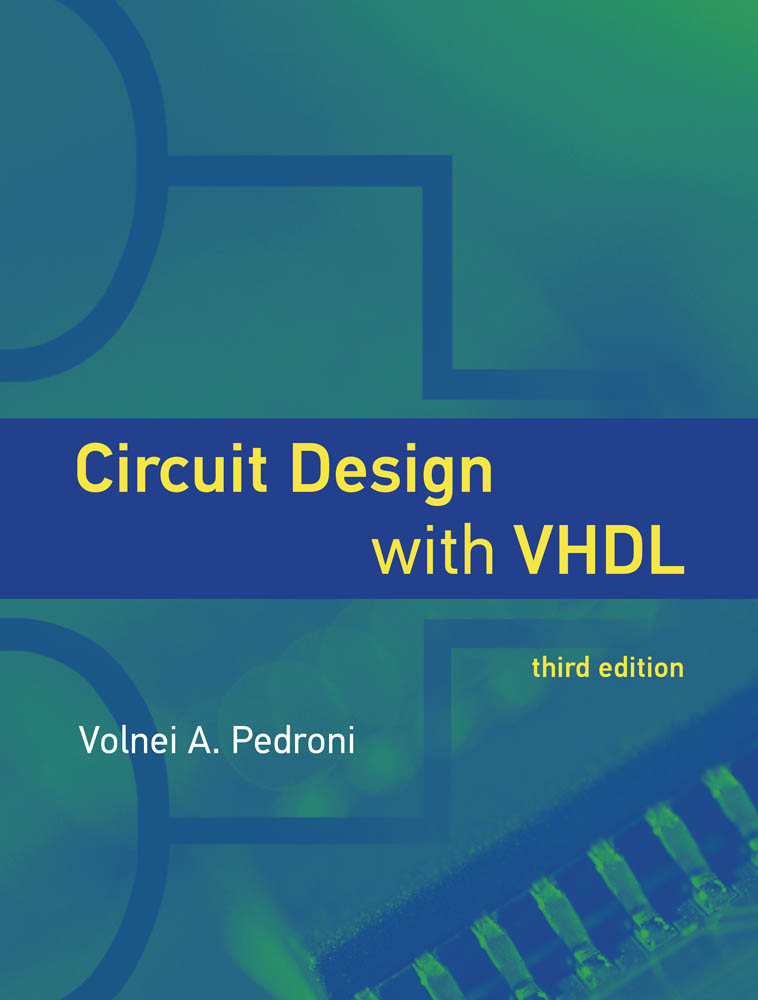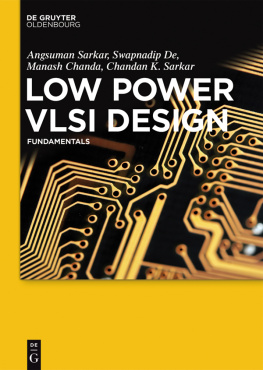Volnei A. Pedroni - Circuit Design with VHDL
Here you can read online Volnei A. Pedroni - Circuit Design with VHDL full text of the book (entire story) in english for free. Download pdf and epub, get meaning, cover and reviews about this ebook. publisher: MIT Press, genre: Home and family. Description of the work, (preface) as well as reviews are available. Best literature library LitArk.com created for fans of good reading and offers a wide selection of genres:
Romance novel
Science fiction
Adventure
Detective
Science
History
Home and family
Prose
Art
Politics
Computer
Non-fiction
Religion
Business
Children
Humor
Choose a favorite category and find really read worthwhile books. Enjoy immersion in the world of imagination, feel the emotions of the characters or learn something new for yourself, make an fascinating discovery.

- Book:Circuit Design with VHDL
- Author:
- Publisher:MIT Press
- Genre:
- Rating:3 / 5
- Favourites:Add to favourites
- Your mark:
- 60
- 1
- 2
- 3
- 4
- 5
Circuit Design with VHDL: summary, description and annotation
We offer to read an annotation, description, summary or preface (depends on what the author of the book "Circuit Design with VHDL" wrote himself). If you haven't found the necessary information about the book — write in the comments, we will try to find it.
Circuit Design with VHDL — read online for free the complete book (whole text) full work
Below is the text of the book, divided by pages. System saving the place of the last page read, allows you to conveniently read the book "Circuit Design with VHDL" online for free, without having to search again every time where you left off. Put a bookmark, and you can go to the page where you finished reading at any time.
Font size:
Interval:
Bookmark:

Circuit Design with VHDL
Third Edition
Volnei A. Pedroni
The MIT Press
Cambridge, Massachusetts
London, England
2020 Massachusetts Institute of Technology
All rights reserved. No part of this book may be reproduced in any form by any electronic or mechanical means (including photocopying, recording, or information storage and retrieval) without permission in writing from the publisher.
Library of Congress Cataloging-in-Publication Data
Names: Pedroni, Volnei A., author.
Title: Circuit design with VHDL / Volnei A. Pedroni.
Description: Third edition. | Cambridge, MA : The MIT Press, [2019] | Includes bibliographical references and index.
Identifiers: LCCN 2018050941 | ISBN 9780262042642 (hardcover ; alk. paper)
Subjects: LCSH: VHDL (Computer hardware description language) | Electronic circuit design. | System design.
Classification: LCC TK7885.7 .P43 2019 | DDC 621.39/5--dc23
LC record available at https://lccn.loc.gov/2018050941
d_r0
List of Fgures
Fundamental logic gates.
(a) Chain-type (linear delay) and (b) tree-type (log delay) structures for combinational processing arrays.
Multiplexer.
Address decoder.
Parity detector: (a) Chain-type (linear delay) and (b) tree-type (log delay) constructions.
A priority encoder: (a) Functional description; (b) Chain-type construction (linear delay); (c) Tree-type construction (log delay).
The need for binary-to-BCD conversion.
Division-based binary-to-BCD converter (a bad idea).
Double-dabble algorithm (illustrated using bin with N = 8 bits).
(a) Construction principle for the double-dabble algorithm (illustrated for bin with N = 9 bits); (b) numeric example, for N = 12 bits, with bin = 111111111111 ( = 4095).
BCD conversion when the signal to be converted is produced by a counter (a particular case).
FA unit: (a) Circuit ports; (b) Truth table; (c) Transistor-level implementation using CMOS logic.
(a) Addition operation and (b) carry-ripple adder.
Faster adders: (a) Dynamic carry-chain Manchester adder; (b) Carry-lookahead adder; (c) Kogge-Stone tree adder.
Adder arrays: (a) Chain type (linear delay) and (b) tree type (log delay).
Adder plus twos complementer, computing s = ab.
(a) Incrementer; (b) Decrementer; (c) Twos complementer.
Parallel multiplier.
Comparators of (a) equality and (b) greater-or-equal plus equality.
Arithmetic logic unit (ALU).
Carry, overflow, and new MSB in addition; (b) Cascaded adders.
(a) Equations for determining the carry-out bit, the overflow flag, and the sums new MSB in unsigned and signed addition; resulting (b) unsigned and (c) signed circuits.
Numeric examples for unsigned addition.
Numeric examples for signed addition.
Multiplication- and division-by-two by means of left or right shift, respectively, for (a) positive and (b) negative integers.
(a) Adder without overflow; (b) Adder with overflow and saturation.
IEEE 754-2008 standard representations for (a) 32- and (b) 64-bit FP numbers.
32-bit FP representations for (a) 5.0 and (b) 1.5.
Floating-point extension.
D-type latches (DLs): (a) Positive-level DL; (b) Negative-level DL; (c) Behavior of a positive-level DL, where the gray shades represent propagation delays.
Examples of DL constructions: (a) Ring of inverters (SRAM-like); (b) Ring of inverters with additional switch; (c) Detailed implementation based on (b).
D-type flip-flops (DFFs): (a) Positive-edge DFF; (b) Negative-edge DFF; (c) Behavior of a positive-edge DFF, where the gray shades represent propagation delays.
(a) Main time parameters of a DFF; (b) Metastability, which can occur when the forbidden time window is violated; (c) Most common synchronizer (also known as two-flop synchronizer).
Construction approaches for DFFs: (a) Master-slave DFF (employs two cascaded DLs of opposite levels); (b) Short-clock-based DFF (employs a single DL with a clock-narrowing circuit); (c) Example of a commercial implementation of the latter (by Intel).
DFFs with (a) enable and (b) clear (i.e., synchronous reset) capabilities.
T-type flip-flops (TFFs): (a) Basic implementation; (b) With toggle-enable capability. A TFF does not involve actual data.
(a) Glitchy and (b) glitch-free combinational outputs; (c) Helpful approach (register after combinational logic), which eliminates glitches and aligns the outputs to the system clock (ready also for clock-domain crossing).
Illustration of RTL abstraction (transfers between registers via combinational logic): (a) General principle; (b)(c) A practical example (finite state machine).
Shift registers: (a) Regular, operating as a serial-in/parallel-out circuit or as a delay line; (b) With data-loading capability, operating as a parallel-in/serial-out circuit.
Synchronous modulo-2 N counters using (a) the traditional serial-enable architecture and (b) the incrementer-based architecture.
Programmable synchronous counters of arbitrary modulo using (a) the traditional serial-enable architecture and (b) the incrementer-based architecture.
Asynchronous counter (each stage produces the clock for the next stage).
(a) Sequential, Gray, Johnson, and one-hot encodings for eight states; (b) Gray counter obtained from a regular counter followed by an XOR layer; (c) Johnson counter; (d) One-hot counter.
Signal generation examples.
Tapped delay line.
(a) Clock division by 6, 7, and 7/3; (b) Important features of the resulting signal.
Generic solution for frequency division by any integer with symmetric glitch-free output.
(a)(d) Clock dividers by even integers; (e)(f) A simple divider by even and odd integers.
Serial counters for a timer with BCD outputs: (a)(b) Each stage produces the clock for the subsequent stage (hence not completely synchronous); (c)(d) All stages are triggered by the same clock (completely synchronous). The former has skew accumulation (though this is fine in some applications) but slightly lower power consumption.
(a) PLL principle; (b) Internal details of the PFD, charge pump, and loop filter blocks.
Synchronization in clock-domain crossing: (a) Single bit, including also an unclocked case (two-flop synchronizer); (b) Data vector with control signal (mux-based synchronizer); (c) Data vector with request and acknowledge signals (handshake-based synchronizer); (d) Pointer transference (Gray-encoded synchronizer).
Frequency meter using Gray code to enter the main clock domain.
Frequency meter using a synchronizer to enter the main clock domain.
Reset alternatives: (a) DFF with conventional (asynchronous) reset; (b) With pseudo-synchronous application and removal; (c) With asynchronous application and truly synchronous removal.
(a) One of three clock-gating arrangements (check the others in the text) and (b) a corresponding timing diagram.
(a) One-shot circuit (reduces pulse length to a single clock period), here preceded by a synchronizer; (b) Pulse capturer (captures pulses that are even shorter than one-half of a clock period), which includes a synchronizer.
Font size:
Interval:
Bookmark:
Similar books «Circuit Design with VHDL»
Look at similar books to Circuit Design with VHDL. We have selected literature similar in name and meaning in the hope of providing readers with more options to find new, interesting, not yet read works.
Discussion, reviews of the book Circuit Design with VHDL and just readers' own opinions. Leave your comments, write what you think about the work, its meaning or the main characters. Specify what exactly you liked and what you didn't like, and why you think so.









